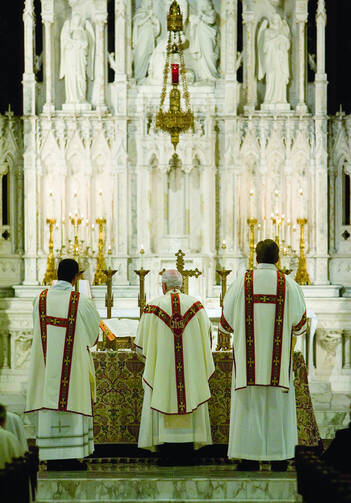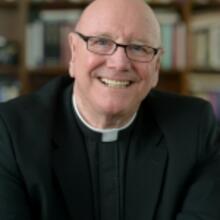In a recent liturgical conference in London, Cardinal Robert Sarah, prefect of the Vatican’s Congregation for Divine Worship and the Discipline of the Sacraments, argued that priests should consider turning toward the East for the celebration of the eucharistic portion of the Mass.
Turning toward the East, or ad orientem, is technical liturgical language for the priest and people facing in the same direction. The suggestion is nothing new. The decision to allow Mass facing the people has had its opponents since it was allowed shortly after the end of the Second Vatican Council. And more recently it has been championed by none less than Cardinal Joseph Ratzinger in his many writings on the liturgy.
Shortly after Cardinal Sarah gave his speech, the Vatican Press Office issued a statement “clarifying” his remarks. In it they made clear that the provisions for Mass facing the people remain in place. We shall see if that ends the matter.
Cardinal Sarah’s speech is likely to cause some conversation in the coming months, as surely some clergy and laity will want to follow his advice. I would like to sort out fact from fiction in the debate over which way the priest should face at the liturgy.
Fact and Fiction
Opponents of Mass facing the people often point out that the Second Vatican Council’s “Constitution on the Sacred Liturgy” contains no provision for the practice. They are correct. The issue was discussed in the commission that produced the document as well as in the debates on the floor of the council. (Annibale Bugnini’s account of the reform, The Reform of the Liturgy: 1948-1975, is an invaluable resource for this material.) But shortly after the constitution was approved in December 1963, the first instruction for implementing the reform appeared. “Inter Oecumenici” (1964) stated: “The main altar should preferably be freestanding, to permit walking around it and celebration facing the people. Its location in the place of worship should be truly central so that the attention of the whole congregation naturally focuses there” (No. 91).
The prescribed placement of the altar was also stated clearly in the General Instruction of the Roman Missal (1969, 3rded. 2002), the church’s official liturgical law. Here are the relevant paragraphs:
296. The altar on which the Sacrifice of the Cross is made present under sacramental signs is also the table of the Lord to which the People of God is called together to participate in the Mass, as well as the center of the thanksgiving that is accomplished through the Eucharist.
299. The altar should be built apart from the wall, in such a way that it is possible to walk around it easily and that Mass can be celebrated at it facing the people, which is desirable wherever possible. The altar should, moreover, be so placed as to be truly the center toward which the attention of the whole congregation of the faithful naturally turns.
The alert reader will observe several things. First, the altar is described as both the place where the “Sacrifice of the Cross is made present” and “the table of the Lord.” (A fuller theological statement would argue that the eucharistic sacrifice and the sacred meal in which we participate are two sides of the same coin). Second, it is interesting to note that facing the people is not mandated. That is, it has never been forbidden, perhaps because too many chapels were built in such a way that having an altar separate from the wall was not architecturally feasible. Nonetheless, the preference is clear that the main altar of a church is to be separated from the wall to make Mass facing the people possible.
Another “fiction” that is sometimes repeated is that the General Instruction presumes that the priest will face East. Critics point to four points in the description of the Mass (Nos. 124, 146, 157 and 165) when the priest is directed to turn towards the people. Two cautions are appropriate here. These directives may be in place to deal with the possibility that the priest can face East, in which case the Instruction makes clear that there are times when he must face the people. But the document does not direct the priest to turn around again to the altar after the prayer over the gifts and the eucharistic prayer—that is, it does not presume that he will be facing East.
One last fact: At the time of Vatican II some argued that the original position of the priest was facing the people. This, too, seems to have been a fiction. All of the evidence we have from the early church shows that facing East whence the Lord was expected to make his final coming was expected. In church building that could not be oriented (e.g., St. Peter’s Basilica in Rome) the priest faced East, which was also toward the people.
What Is At Stake?
There is a great deal at stake in the argument over which way the priest should face. Three reasons are often cited for facing East. The first is that the people are involved in a common action and therefore should face the Lord in offering the eucharistic sacrifice. The second is that the personality of the priest now dominates in the liturgy—to its detriment. Third, the current arrangement makes the celebration a self-enclosed circle in which the community becomes the object of its own worship. These arguments are not unreasonable; there have been many situations that warrant these criticisms over the past 50 years.
On the other hand, the arguments do not seem sufficient to warrant changing the current practice of facing the people during the celebration of the Eucharist. The abuses and excesses of the decades following the institution of the liturgical reform are for the most part a thing of the past. No doubt there are occasional exceptions, which some bloggers are eager to pounce on.
The decision to make versus populum celebration a possibility rested on a profound theological insight, one which is profoundly traditional. The Eucharist is the action of the church—head and members. This sacred action is a sacrifice (self-offering along with Christ) that takes the form of meal, in which the body and blood of the Lord are given and shared. (This latter point invites more emphasis than I can expand on here. Suffice it to say that current attitudes toward receiving Communion in a consumerist culture often obscure the fact that Communion is something we share with one another as the body of Christ). It was perfectly clear to St. Paul (I Cor 10-11) and St. Augustine (Sermon 227, 272) that we receive the body of Christ in order to become the body of Christ. Hence the importance of the council’s clarion call for full, conscious and active participation in the liturgy.
Last, as the church historian Massimo Faggioli has frequently and astutely argued, liturgical reform is an interpretive key to the whole of the council. A reversion to the pre-conciliar position of the priest at Mass would be a profound signal that the forward steps the church took in Vatican II are in question. I suspect that a good number of people who make the ad orientem argument are in favor of just such a reversal.
In 2000, the Congregation of Divine Worship and the Disciple of the Sacraments issued a statement responding to an inquiry regarding ad orientem and versus populum. They were on target in insisting that the question really depends of making Christ the center of the celebration. I would add that it is important to keep emphasizing that the body of Christ is present both on the altar and in the assembly—not to mention in the priest and the word of God as stated by the “Constitution on Sacred Liturgy” (No. 7) and the General Instruction (No. 27). What is very much at stake in our liturgical celebrations is the reverence we have for all of these modes of the presence of Christ.
John F. Baldovin, S.J., teaches liturgy and sacraments at the Boston College School of Theology and Ministry.
Correction, July 22: Due to an editing error, the timing of the liturgical conference held in London cited in the first paragraph was initially incorrect. The conference was held in July, not May.








